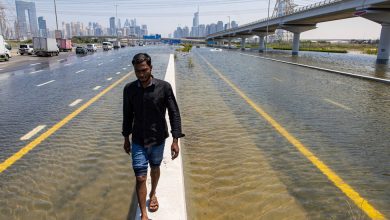Here’s What Changes When New York Raises Its Covid Risk Level

As coronavirus cases rise again, fueled by BA.2, the highly contagious Omicron subvariant, New York City is on the cusp of moving to a yellow or medium risk level from a green or low risk level. But what does that mean for the city’s residents and what precautions should they take? And what restrictions might the city enact in response to the increased threat?
Here is what you need to know:
What is the city’s Covid-19 alert level system?
The city’s new alert level system, which debuted in early March, is based on metrics set by the Centers for Disease Control and Prevention that attempt to give people and local governments a sense of when they should take extra precautions, such as wearing masks indoors, to prevent transmission of the coronavirus. The system uses three metrics to determine risk: the number of cases per 100,000 people in the last seven days, new Covid hospital admissions per 100,000 people in the last seven days and the percentage of hospital beds that are occupied by Covid patients.
A previous system, which the C.D.C. used for much of the pandemic, did not take into account hospitalization rates and set the trigger for colored-coded risk levels at far lower case rates. Based on the old system, most of the Northeast, including New York City, would already be considered a red or high transmission zone, even though hospitalizations from the subvariant remain low in most places.
In New York City, a risk level of green means there is “lower” community spread of Covid-19. As long as new Covid-19 cases stay below 200 per 100,000 residents per week in the city, and hospitalizations remain low, the alert level stays green. Once new cases reach 200 per 100,000 residents, even if hospitalizations remain low, a yellow alert is triggered, meaning the risk level is “medium.” Hospitalizations above 10 new Covid-19 admissions per 100,000 per week, even at low case rates, can also trigger a yellow level. Covid-19 hospitalizations must be high to trigger an orange, or high alert.
The city also introduced its own fourth alert level — red or very high — used only when cases are above 200 per 100,000 residents and hospitals are more than 90 percent full, indicating that health care services are overwhelmed.
Each threshold comes with recommended actions, but no mandates. It is up to Mayor Eric Adams to decide what extra precautions the city should take, if any.
How close is the city to reaching the yellow alert level?
As of Tuesday, the city recorded 190 new cases per 100,000 people during the week that ended April 16.
The city’s Covid-19 hospitalization levels are still low but have started to climb. The city recorded five new hospital admissions per 100,000 people for Covid in the last week, but only 2 percent of its hospital beds were occupied by Covid-19 patients.
Manhattan, which has had more than 300 cases per 100,000 people per week since April 8, has been at the yellow alert level for more than three weeks. Staten Island crossed over into yellow on Tuesday. The city did not publicize those shifts because it uses only one alert level for the entire city, and the other boroughs have so far remained green. But they are slowly catching up.
Nearby suburban counties, including Westchester and Nassau, and Bergen County in New Jersey, had already reached the yellow alert level as of Monday, according to the C.D.C. And 10 counties in upstate New York, where the state health department has issued a warning regarding clusters of two new, more transmissible BA.2 sublineages, are among less than 1 percent of counties in the nation at orange, or high alert.
What actions are recommended when the city goes from a low to medium alert level?
The city’s health department maintains a list of recommendations and considerations that individuals and the government should consider once the city hits a medium alert level. Mr. Adams should consider bringing back masking in schools and vaccination checks at restaurants and indoor entertainment sites, for example.
On an individual level, the health department recommends that people wear masks in public indoor settings where the vaccine status of others is unknown once the alert level reaches yellow. (It recommended people consider doing so at green, a slight difference). High-risk and unvaccinated people should take extra precautions.
Mr. Adams said on Monday that he would weigh additional citywide restrictions if the alert level changed but that he remained undecided for now. Mr. Adams, a Democrat who took office in January, has been focused on the city’s economic recovery and rolled back some restrictions in March when cases were low.
Mr. Adams, who tested positive for the virus on April 10 after waking up with a raspy voice, returned to City Hall on Monday wearing a high-quality mask. He encouraged New Yorkers to wear a mask in public if they felt uncomfortable or did not know the vaccination status of people around them.
“There is an encouragement we’re putting out to New Yorkers,” he said in reference to masks. “We’re just not in a place of a mandate right now.”
The city has been following its green level recommendations, which include: maintaining the city’s employer and school vaccine mandates; maintaining mask mandates in health care settings and on public transportation; and ensuring access to testing, vaccines and treatment.
Although a federal judge in Florida struck down the nationwide transportation mandate on Monday, allowing major airlines, Amtrak, and many mass transit systems to make masking voluntary, the Metropolitan Transportation Authority in New York City has said it will continue to require masks on its buses, subways and trains.
How good is the alert system as an early warning for surges?
Not great, some experts say, in part because it does not take into account the huge rise in home testing, which likely accounts for most cases at this point.
“I think the true number of infections in New York City is probably three to five times the number of diagnosed cases these days,” said Dr. Denis Nash, a professor of epidemiology at the City University of New York who studied transmission trends during the city’s first Omicron surge.
In addition, while hospitalizations and hospital occupancy are useful metrics, they may not rise until weeks after a surge in transmission. In that sense, an alert system based in large part on hospital metrics does not provide an adequate picture of risk, Dr. Nash said.
Many experts have also criticized the new C.D.C. alert levels for downplaying risk, noting that health care facilities are still supposed to be using the older system, which views areas as high risk once cases hit 100 per 100,000 residents per week.
“What the C.D.C. did, changing that, was in my view irresponsible,” said Dr. Eric Topol, a professor of Molecular Medicine at Scripps Research.
The city’s health department, however, stood behind its current alert level system, adding that the rise in home testing was helping people get treatment sooner, and reducing hospitalizations and deaths, which have remained low so far.
“The Health Department is monitoring the reported cases as well as other indicators, such as hospitalizations, to gauge the overall situation in New York City,” said Michael Lanza, a Health Department spokesman, in a statement.
Emma G. Fitzsimmons contributed reporting.



